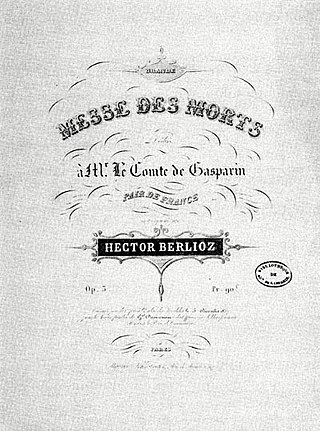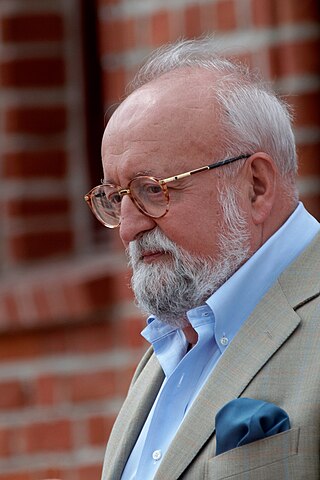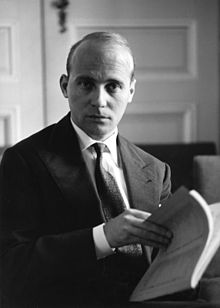
The Messa da Requiem is a musical setting of the Catholic funeral mass (Requiem) for four soloists, double choir and orchestra by Giuseppe Verdi. It was composed in memory of Alessandro Manzoni, whom Verdi admired. The first performance, at the San Marco church in Milan on 22 May 1874, marked the first anniversary of Manzoni's death.

The Requiem in D minor, K. 626, is a Requiem Mass by Wolfgang Amadeus Mozart (1756–1791). Mozart composed part of the Requiem in Vienna in late 1791, but it was unfinished at his death on 5 December the same year. A completed version dated 1792 by Franz Xaver Süssmayr was delivered to Count Franz von Walsegg, who had commissioned the piece for a requiem service on 14 February 1792 to commemorate the first anniversary of the death of his wife Anna at the age of 20 on 14 February 1791.

Hans Werner Henze was a German composer. His large oeuvre is extremely varied in style, having been influenced by serialism, atonality, Stravinsky, Italian music, Arabic music and jazz, as well as traditional schools of German composition. In particular, his stage works reflect "his consistent cultivation of music for the theatre throughout his life".

The Grande Messe des morts, Op. 5, by Hector Berlioz was composed in 1837. The Grande Messe des Morts is one of Berlioz's best-known works, with a tremendous orchestration of woodwind and brass instruments, including four antiphonal offstage brass ensembles. The work derives its text from the traditional Latin Requiem Mass. It has a duration of approximately ninety minutes, although there are faster recordings of under seventy-five minutes.
Andrew Lloyd Webber's Requiem is a requiem mass, which premiered in 1985. It was written in memory of the composer's father, William Lloyd Webber, who died in 1982.

The Requiem, Op. 9, is a 1947 setting of the Latin Requiem by Maurice Duruflé for a solo baritone, mezzo-soprano, mixed choir, and organ, or orchestra with organ. The thematic material is mostly taken from the Mass for the Dead in Gregorian chant. The Requiem was first published in 1948 by Durand in an organ version.

Polish Requiem, also A Polish Requiem, is a large-scale requiem mass for soloists, mixed choir and orchestra by the Polish composer Krzysztof Penderecki. The Lacrimosa, dedicated to the trade union leader Lech Wałęsa, was written for the unveiling of a statue at the Gdańsk Shipyard to commemorate those killed in the Polish anti-government riots in 1970. He expanded the work into a requiem, writing other parts to honour different patriotic events over the next four years.
Antonín Dvořák's Requiem in B♭ minor, Op. 89, B. 165, is a funeral Mass scored for soloists, choir and orchestra. It was composed in 1890 and performed for the first time on 9 October 1891, in Birmingham, England, with the composer conducting.
Requiem Canticles is a 15-minute composition by Igor Stravinsky, for contralto and bass soli, chorus, and orchestra. Stravinsky completed the work in 1966, and it received its first performance that same year.
Michael Vyner was an English arts administrator.
Marcel Wengler is a Luxembourg composer and conductor. From 1972–1997, he headed the Conservatoire de Luxembourg. Since 2000, he has been director of the Luxembourg Music Information Centre. His compositions include symphonies, concertos, chamber music and musicals.
Fantasia for Strings is a composition by German composer Hans Werner Henze. It was finished in 1966, as part of the soundtrack for Volker Schlöndorff's film adaptation of Robert Musil's novel The Confusions of Young Törless. This composition has been published by Schott Music.
In music, sotto voce is a dramatic lowering of the vocal or instrumental volume—not necessarily pianissimo, but a definitely hushed tonal quality.
The Requiem is a composition for soprano, mezzo-soprano, tenor, baritone, chorus, and orchestra by the American composer John Harbison. Composed over a period of seventeen years, the complete work was finished in 2002 on a commission from the Boston Symphony Orchestra. Its world premiere was given by the soprano Christine Brewer, mezzo-soprano Margaret Lattimore, tenor Paul Groves, baritone Jonathan Lemalu the Tanglewood Festival Chorus, and the Boston Symphony Orchestra under the direction of Bernard Haitink on March 6, 2003.
The String Sonata No. 1, commonly referred to by its original Italian name Sonata per archi, is a composition for string orchestra by German composer Hans Werner Henze. It was composed between 1957 and 1958.
This article lists some of the modern completions of the Requiem by Wolfgang Amadeus Mozart.
The Requiem by the Hungarian composer György Ligeti is a large-scale choral and orchestral composition, composed between 1963 and 1965.

The Messa da requiem in D minor (1835) is a musical setting of the Catholic funeral mass (Requiem) by Italian opera composer Gaetano Donizetti. It is scored for five soloists, mixed chorus and orchestra. A performance lasts about 62–75 minutes.







